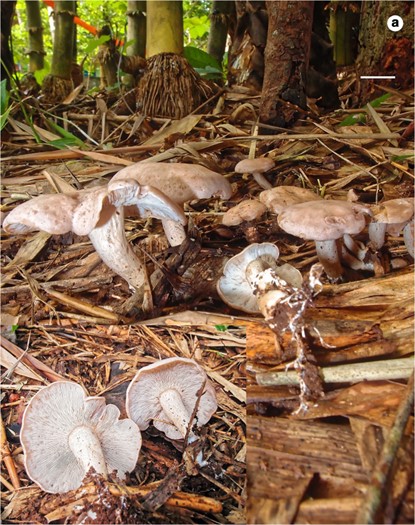Anupama indica K.N.A. Raj, K.P.D. Latha & Manim., sp. nov. (Figs. 3 and 4)
MycoBank number: MB 828253; Index Fungorum number: IF 828253; Facesoffungi number: FoF;
Etymology: The specific epithet refers to India, the country where this species was first discovered.
Typus. India: Kerala State, Malappuram District, Mayilanji Valavu, 11° 07.958′ N, 075° 52.479′ E, on soil among decaying bamboo leaf litter under bamboo (Bambusa striata Lodd. Ex Lindl.), 28 Jun. 2017, K. N. Anil Raj and K. P. Deepna Latha DKP500 (holotype CAL 1725).
Diagnosis: Habit tricholomatoid. Pileus surface brownish, hygrophanous and becoming paler, glabrous and somewhat waxy. Lamellae sinuate, orange-gray, crowded, furcate, with concolorous edges. Stipe central or slightly eccentric, tapered towards the base, solid, with white mycelial cords at the base; surface densely appressed-fibrillose all over, orange-gray. Spore print grayish white. Odor pleasant, rather fruity. Basidiospores subglobose, obovoid or somewhat lacrymoid, smooth, hyaline or pale yellow, inamyloid, acyanophilic. Pleurocystidia scarce. Cheilocystidia abundant, versiform. Pileipellis a cutis. Clamp connections observed on all hyphae. nrITS, nrLSU, and rpb2 sequences distinctive.
Basidiocarps small to medium-sized, tricholomatoid. Pileus 15–58 mm diam., convex when young, becoming broadly convex to plano-convex or almost applanate with or without a low, broad umbo occasionally surrounded by a shallow depression at maturity; surface brownish orange (5C4, 6C3/OAC799, OAC669) or light brown (6D3/OAC641) when young, becoming orange-gray (6B2/OAC676) and finally brownish gray (7C2/OAC613), hygrophanous and becoming paler, glabrous and somewhat waxy to the naked eye, finely pruinose under a lens; margin almost inrolled when young, becoming incurved to somewhat decurved with age, rather lobate. Lamellae sinuate, orange-gray (6B2/OAC676) when young, becoming pale orange (5A3/OAC792) or orange-gray (5B2, 5B3/OAC793) with age, up to 6 mm wide, crowded, furcate, with lamellulae in several tiers; edge initially entire, becoming crenate or wavy, concolorous with the sides. Stipe 12–63 × 3–17 mm, central or slightly eccentric, terete or slightly compressed, tapered towards the base, solid; surface densely appressed-fibrillose all over, orange-gray (5B2/OAC808) or paler all over; base with white tomentum and long, white, and subterranean mycelial cords. Context up to 5 mm wide, white, soft. Odor pleasant, rather fruity. Taste not distinctive. Spore print grayish white (1B1/OAC907). Basidiospores 3–4(4.5) × (2)2.5–3(3.5) (3.54 ± 0.45 × 2.94 ± 0.23) μm, Q = 1.0–1.6, Qm = 1.20, subglobose, obovoid or somewhat lacrymoid, smooth, hyaline or pale yellow, thin- walled, inamyloid, acynophilous, showing a Bnodulose^ type hilum in scanning electron microscope images. Basidia 19– 29 × 4–7 μm, clavate, hyaline or pale yellow, thin-walled,
inamyloid, without siderophilous granules, four-spored; sterig- mata up to 4 μm long. Lamella-edge heteromorphous. Cheilocystidia 25–81 × 3.5–5 μm, abundant, versiform: flexuous, cylindrical, cylindrical with a mucronate apex and a bulbous base, lageniform or clavate, with a pale yellow wall pigment, thin-walled. Pleurocystidia intermixed with basidioles, 12–35 × 4–5 μm, scarce, versiform: fusiform, lageniform, flexuous, cylindrical or cylindrical with a mucronate apex, with a pale yellow wall pigment, thin-walled. Pseudocystidia absent. Lamellar trama subregular; hyphae 4–16 μm wide, with a pale yellow wall pigment and fine yellowish brown encrustations, thin- to slightly thick-walled, inamyloid. Pileus trama interwoven: hyphae 6–14 μm wide, thin-walled, with a pale yellow wall pigment, inamyloid. Pileipellis a cutis; hyphae 3–8 μm wide, with pale brownish yellow plasmatic contents and yellowish brown encrustations, thin- to slightly thick-walled. Stipitipellis a disrupted cutis; hyphae 3–9 μm wide, thin-walled, with a pale yellow wall pigment, inamyloid. Caulocystidia absent. Clamp connections observed on all hyphae.
Habitat: In small groups, occasionally scattered singly on the soil under bamboo (Bambusa striata).
Distribution: India, Kerala State.
Additional specimens examined: India: Kerala State, Malappuram District, Mayilanji Valavu, 11° 07.958′ N, 075° 52.479′ E, on soil among decaying bamboo leaf litter under bamboo (Bambusa striata), 07 Jul. 2017, K. N. Anil Raj AR1113 (AMH 10030); 26 Jul. 2017, K. N. Anil Raj AR1115 (AMH 10029); 17 Aug. 2017, K. N. Anil Raj AR1118 (AMH 10031); 20 Sep. 2017, K. N. Anil Raj AR1122 (AMH 10032); 06 Aug. 2018, K. P. Deepna Latha DKP528 (AMH 10033).
DNA barcodes generated : nrITS (MH989583 – MH989586), nrLSU (MH989587–MH989590), rpb2 (MH992116, MH992117).

Fig. 3 Anupama indica (CAL 1725, holotype). A. Basidiocarps in their natural habitat. Scale bar: A = 10 mm

Fig. 4 Anupama indica (CAL 1725, holotype). a Basidiospores. b SEM image of basidiospore showing the Bnodulose^ type hilum. c Basidium. d Pleurocystidia. e Lamella-edge showing cheilocystidia. f Cheilocystidia. g Pileipellis. h Stipitipellis. i Clamp connection on the hyphae of pileipellis. Scale bars: a, c–f, i = 10 μm; b =1 μm; g–h = 20 μm
